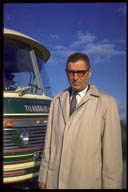Henry Longstreet Taylor, PhD
1912 — 1983

Henry Longstreet Taylor was born in St. Paul, Minnesota, and educated at Harvard College, where he worked as a student in the Fatigue Laboratory, and at the University of Minnesota, where he received a PhD in Physiology in 1941. There he joined Ancel Keys’s new Laboratory of Physiological Hygiene and his research established maximum VO2 consumption as the standard measure of aerobic work capacity. He early documented the deconditioning effects of bed rest and semi-starvation and developed a widely used standard measuring tool, a questionnaire for leisure-time physical activity. He was a pioneer in the study of habitual physical activity of work and leisure and of work performance, and their relation to cardiovascular risk and health in populations.
Taylor’s study of CVD in active and sedentary rail populations became one of the Seven Countries Study cohorts and demonstrated no significant occupational differences in risk but confirmed the universality of the risk factor hypotheses. He was a consummate field epidemiologist and developed many of the strategies used in subsequent Minnesota cohorts and trials. His experience put the Laboratory in a strong position at the time Ancel Keys retired in 1972 to contribute to the design and operation of the major preventive trials of the 1970s and ’80s: the Hypertension Detection & Follow-up Program (HDFP), The Lipid Research Centers, The Multiple Risk Factor Intervention Trial (MRFIT), and cholesterol-lowering diet and drug trials.
Taylor led the national Pilot Trial of Physical Activity and Coronary Heart Disease and came to the conclusion that a primary prevention trial focused on the causal role of exercise was not feasible due to complexity and confounding. With his collaborators in the trial, Richard Remington and Jerry Stamler, Taylor designed the first proposal to NIH for a multiple risk factor trial of prevention. It was not favorably reviewed but had adequate sample size and factorial design that unfortunately were not incorporated into the NIH-designed MRFIT.
Henry Taylor was known and beloved for his folksy ways, his consultative style of administration, and his tough but effective mentoring of young investigators. (HB)
Please click here for a description of the U.S. Railroad Study.
Related Content
Audio Clips
- Henry Taylor Symposium 1982 – Part 2 Paffenbarger and Hellerstein
- Henry Taylor Symposium 1982 – Part 1 Remington, Haskell, and Luepker Remarks
Essays
Eulogies and Obituaries
Photographs
- Taylor, Henry, PhD (1912-1983)
- Participants in the Makarska Conference on Mass Field Trials in the Prevention of Coronary Heart Disease